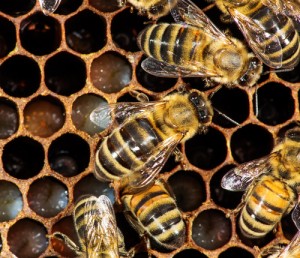When someone mentions honey bees you may think of two things: the sweet taste of honey from their hives and the painful stings that they can inflict. But honey bees have an especially important role in agriculture; they are responsible for 80 percent of all pollination of fruit trees by insects. Without this small insect, you would not be able to enjoy peaches, apples and pears and other fruits.
To determine if the buzzing insect you’re seeing is a honey bee, look for these characteristics:
- About ¾ inch long
- Reddish brown to black in color, with orange-yellow rings on the abdomen
- Thick, pale hair on the thorax (midsection of body)


Honey bees are social and cooperative insects. They live together in hives consisting of 20,000-30,000 bees during the winter, but that number can increase to 60,000 to 80,000 in the winter.
There is just one queen bee for each hive, and she mates once with several drone (male) bees. After that she remains fertile her entire life and can lay up to 2,000 eggs a day. Fertilized eggs become workers; unfertilized eggs are the drones. When a queen dies, the workers select a larva and feed it royal jelly made from digested pollen and honey or nectar, plus a chemical from a nursing bee’s head.
Queens can live for several years. Workers live 6 to 8 weeks in summer, but if they are born late in the year they will overwinter in the hive—often clustering together for warmth–and last 4 to 9 months. Drones aren’t as lucky—when the cold weather comes, they get kicked out of the hive.
Food sources for honey bees include nectar and pollen from clover, dandelions, goldenrod, milkweed and fruit trees. The larvae in the hive eat honey produced by workers.

As a Home Protection Plan customer, if you’re not satisfied with our pest control service, we will service your home at no additional cost until your issue is solved or receive your money back from your last scheduled service.

Since honey bees like sweet flowers, they may come around if you’re wearing perfume or have used certain scents of soap or hair sprays. Usually, however, they won’t bother you unless you pick a fight with them.
If you do alarm one bee, you can expect to be surrounded by many more; when they are stressed they release an alarm pheromone that alerts other members of the hive to the danger. Only the female bees can sting, and because their stinger is barbed they die after stinging.
Honey bees like their hives in meadows, gardens, orchards—anywhere where there’s a good supply of food.
If you do have one on your property, it’s best to let it remain unless it is posing an imminent threat, since honey bees are disappearing quickly.


